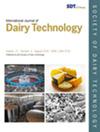Complexing whey protein isolate with polysaccharide to ameliorate freezing-induced damage of cream cheese
Abstract
Rationale
Freezing dairy foods can result in textural quality loss. There is a need for food-grade antifreeze agents for long-term storage.
Aim
This study aimed to develop dairy protein–polysaccharide complexes, assess their ice recrystallisation inhibition effect and reduce freezing-induced damage by incorporating them into a commercial cream cheese spread.
Methods
Complex formation between whey protein isolate and locust bean gum (LBG) or lambda carrageenan (λCG), as well as complexes between their hydrolysates, was made and confirmed by particle size, zeta potential, surface hydrophobicity analyses and FTIR.
Major Findings
The complexes made from the unhydrolyzed biopolymers showed ~66% ice crystal size relative to a negative control for both gum types. The cream cheese spread with complex addition at 4% dry-weight basis and after repeated freeze-thaw treatment cycles showed general trends of all complex treatments containing λCG having rheological and textural properties more similar to the fresh control spread compared to the protein alone and other treatments containing LBG. The storage modulus (G’) of the treatments with complexes formed between WPI and λCG and their hydrolysates are between 200–250 KPa, similar to that of untreated control. The adhesiveness of the treatments with complexes formed between WPI and λCG and their hydrolysates, as well as the λCG gums, are also more similar to the controls (50 vs 25 g.sec), compared to the other treatments (150–250 g.sec).
Industrial Implications
When the study is further validated by applying the treatments to the proper processing steps and products evaluated under more relevant conditions, the impact of such novel antifreezing complex on dairy product quality will be better demonstrated.


 求助内容:
求助内容: 应助结果提醒方式:
应助结果提醒方式:


